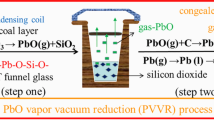Abstract
Cathode ray tube (CRT) funnel glass remains an urgent environmental problem and is composed mainly of lead oxide and silicon oxide. In this research, the residue could be obtained from 2 h to 500 rpm activated CRT funnel glass after extracting lead via acid leaching under the conditions of HNO3 concentration 1.0 mol/L, leaching temperature 95 °C and leaching time 1 h. In order to reutilize the residue, its physico-chemical properties were characterized by scanning electron microscopy, Brunauer–Emmett–Teller, thermogravimetric analysis, X-ray diffraction and Fourier transform infrared spectroscopy. The results indicated that the residue was an amorphous superfine powder with approximately 93 wt% silica oxide and specific surface area of more than 170 m2/g. It can be reutilized as white carbon black.







Similar content being viewed by others
References
Yuan WY, Li JH, Zhang QW, Saito F (2012) Innovated application of mechanical activation to separate lead from scrap cathode ray tube funnel glass. Environ Sci Technol 46:4109–4114
Lee CH, Chang TC, Kuo SF, Tien CC (2004) An overview of recycling and treatment of scrap computers. J Hazard Mater 114:93–100
Méar F, Yot P, Cambon M, Ribes M (2006) The characterization of waste cathode ray tube glass. Waste Manag 26:1468–1476
Poon CS (2008) Management of CRT glass from discarded computer monitors and TV sets. Waste Manag 28:1499
Heart S (2008) Recycling of cathode ray tubes (CRTs) in electronic waste. Clean 36:19–24
Jeremy RG, Marie CN, Randolph EK (2009) Evaluating the economic viability of a material recovery system: the case of cathode ray tube glass. Environ Sci Technol 43:9245–9251
Li JH, Wen XF (2006) Electronic waste treatment technology. China Environmental Science Press, Beijing
Jang YC, Townsend TG (2003) Leaching of lead from computer printed wire boards and cathode ray tubes by municipal solid waste landfill leachates. Environ Sci Technol 37:4778–4784
Musson SE, Jang YC, Townsend TG, Chung IH (2000) Characterization of lead leachability from cathode ray tubes using the toxicity characteristic leaching procedure. Environ Sci Technol 34:4376–4381
Spalvins E, Dubey B, Townsend TG (2008) Impact of electronic waste disposal on lead concentrations in landfill leachate. Environ Sci Technol 42:7452–7458
Yuan WY, Li JH, Zhang QW, Satio F, Yang B (2013) Lead recovery from cathode ray tube funnel glass with mechanical activation. J Air Waste Manag Assoc 63:2–10
Yuan WY, Li JH, Zhang QW, Satio F, Yang B (2013) A novel process utilizing mechanochemical sulfidization to remove lead from cathode ray tube funnel glass. J Air Waste Manag Assoc 63:418–423
Chen MJ, Zhang FS, Zhu JX (2009) Lead recovery and the feasibility of foam glass production from funnel glass of dismantled cathode ray tube through pyrovacuum process. J Hazard Mater 161:1109–1113
Yot PG, Méar F (2009) Lead extraction from waste funnel cathode-ray tubes glasses by reaction with silicon carbide and titanium nitride. J Hazard Mater 172:117–123
Miyoshi H, Chen DP, Akai T (2003) A novel process utilizing subcritical water to remove lead from wasted lead silicate glass. Chem Lett 33:956–957
Saterlay AJ, Wilkins SJ, Compton RG (2001) Towards greener disposal of waste cathode ray tubes via ultrasonically enhanced lead leaching. Green Chem 3:149–155
Zhang CL, Wang JW, Jf Bai, Guan J, Wu WJ, Guo CX (2013) Recoverying lead from cathode ray tube funnel glass by mechano-chemical extraction in alkaline solution. Waste Manag Res 31:759–763
Hao SF, Zheng ZX, Fan WQ, Xu GQ, Lv J, Wu YC (2011) Study on precipitated SiO2 surfactant modified and its properties. Bull Chin Ceram Soc 30:529–533
Tan X, Zhong H (2010) Research progress and preparation of amorphous silica. Technol Dev Chem Ind 39:25–31
Zhang JL, Guo ZC, Zhi X, Tang HQ (2013) Surface modification of ultrafine precipitated silica with 3-methacryloxypropyltrimethoxysilane in carbonization process. Colloid Surf A 418:174–179
Tai YL, Qian JS, Zhang YC, Huang JD (2008) Study of surface modification of nano-SiO2with macromolecular coupling agent (LMPB-g-MAH). Chem Eng J 141:354–361
Gao YX, Gu XR (1984) Surface structure of amorphous silica. Petrochem Technol 13:205–212
Ministry of Environmental Protection of the People’s Republic of China (2007) Identification standards for hazardous wastes—identification for extraction toxicity (GB 5085.3-2007), Beijing
Acknowledgments
This study was financially supported, in part, by the National Nature Science Foundation of China (21177069), Natural Science Foundation of Shanghai (14ZR1416700) and Knowledge Service Platform Program of Shanghai (ZF1224).
Author information
Authors and Affiliations
Corresponding author
Rights and permissions
About this article
Cite this article
Yuan, W., Yao, Z., Zhang, Q. et al. Characterization of residue from leached cathode ray tube funnel glass: reutilization as white carbon black. J Mater Cycles Waste Manag 16, 629–634 (2014). https://doi.org/10.1007/s10163-014-0291-5
Received:
Accepted:
Published:
Issue Date:
DOI: https://doi.org/10.1007/s10163-014-0291-5




